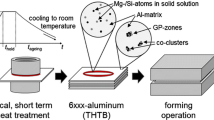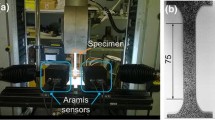Abstract
While in industries lightweight construction gain an increasingly significant role and as weight reduction is often done with aluminum sheets, advanced production technologies have to be developed to be competitive for this evolution. Since steel sheet metal parts cannot be substituted directly with aluminum due to its minor formability, the usage of so called tailored heat treated blanks (THTB) is presented in this work. THTB are locally heat treated aluminum blanks from the 6,000-series alloy which exhibit a specific strength pattern optimized to the forming operation leading to a significantly improved formability for the manufacturing of complex aluminum car body parts. The enhancement of the formability is reached by a local heat treatment before the forming process. Due to the strong interdependency of heat treatment and forming operation, a numerical investigation of the process sequence is a prerequisite for a cost-effective usage of the THTB. An inverse approach on basis of a finite element simulation enables the determination of process parameters for an optimized THTB, thus having an effective and efficient engineering method for this technology.








Similar content being viewed by others
References
Geiger M, Merklein M, Kerausch M (2004) Microstructural investigations of aluminum tailored heat treated blanks. In: WGP (Hrsg.): Production Engineering. Annals of the German Academic Society for Production Engineering WGP XI/2, pp 47–50
Merklein M, Vogt U (2007) Application of tailored heat treated blanks under quasi series conditions. In: Proceedings of the 12th international conference on sheet metal (SheMet), Trans Tech Publications Ltd, pp 383–390
Siebel E, Beisswänger H (1953) Ziehversuche mit hartgewalzten und partiell geglühten Ronden zur Erhöhung des Ziehverhältnisses. In: Mitteilungen für die Mitglieder der Forschungsgesellschaft Blechverarbeitung. Düsseldorf 7:89–93
Hofmann A (2002) Erweiterung der Formgebungsgrenzen beim Umformen von Aluminiumwerkstoffen durch den Einsatz prozessangepasster Platinen. Dissertation Universität Erlangen
Geiger M, Merklein M, Kerausch M (2004) Finite element simulation of deep drawing of tailored heat treated blanks. Annal CIRP 53(1):223–226
Hogg M (2006) Herstellung und Umformung lokal wärmebehandelter Platinen. Dissertation Universität Stuttgart
Kirkpatrick S, Gelatt CD Jr, Vecchi MP (1983) Optimisation by simulated annealing. Science 220(4598):671–680
Ingber L (1989) Very fast simulated re-annealing. J Math Comput Modelling 12:967–973
Author information
Authors and Affiliations
Corresponding author
Additional information
The investigations presented in this paper were carried out within the project CRC 396 B4 “Robust, shortened process sequences for lightweight sheet parts” sponsored by the German Research Foundation (DFG).
Rights and permissions
About this article
Cite this article
Geiger, M., Merklein, M., Staud, D. et al. An inverse approach to the numerical design of the process sequence of tailored heat treated blanks. Prod. Eng. Res. Devel. 2, 15–20 (2008). https://doi.org/10.1007/s11740-007-0072-2
Received:
Accepted:
Published:
Issue Date:
DOI: https://doi.org/10.1007/s11740-007-0072-2




